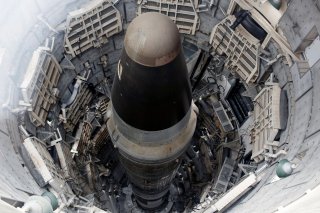How to Buy Decision-Making Time During a Nuclear Attack
In effect, when Spaced-Based Infrared sensors (SBIR) detect the heat and light signature of an enemy missile launch, the data is then networked to key ground sites and passed to the appropriate decision-makers such as the President.
Here's What You Need To Remember: Using cloud technology in this fashion enables otherwise disparate servers and fixed locations to see threat data simultaneously, thus expediting response protocol. An enemy ICBM would typically take about twenty to thirty minutes traveling through space en route to its target, creating time pressure as lives hang in the balance.
The Pentagon and industry are taking new technical steps to quickly alert commanders in the event that the United States comes under nuclear attack by increasing the time window with which decision makers have to both defend and potentially retaliate.
(This article first appeared in July 2019.)
This includes using emerging software and hardware technologies and new architecture to migrate time-sensitive targeting data to the cloud, increase network resiliency and better connect space, air and ground nodes into a fast, seamless integrated threat analysis system.
The current work, which includes new technical methods of engineering communications nodes within a broad network, is part of an overall Pentagon strategy to improve missile warning systems as quickly as new technology emerges. The effort, according to Missile Defense Agency officials, can be described as ongoing improvement of its Command and Control, Battle Management and Communications System.
“We continuously upgrade and improve our existing systems to make sure the warfighter has the most effective system available to defend the country. We call it spiral development where we put something that is working out into the field and then don’t stop there. We look for the next improvements such as software upgrades,” Mark Wright, Chief Spokesman, Missile Defense Agency, told TNI.
The aim of C2BMC, according to MDA statements, is to “collectively see the battle develop and dynamically manage designated network sensors.”
Wright explained that the strategic and tactical intent, for instance, is to network various space-based, terrestrial and maritime sensor assets to create a coordinated picture of fast-approaching attacks. He mentioned, for example, that this would include connecting ship-based Aegis radar with air assets or ground-based THAAD (Terminal High Altitude Area Defense) missile batteries.
One key program now under development by the Air Force and industry partners such as Raytheon is called FORGE (Future Operationally Resilient Ground Enterprise), a technical apparatus engineered to gather, store, safeguard and network missile-attack related sensor information. It involves synchronizing fixed ground terminals with other nodes such as air and space assets; it also leverages cloud technology. In effect, when Spaced-Based Infrared sensors (SBIR) detect the heat and light signature of an enemy missile launch, the data is then networked to key ground sites and passed to the appropriate decision-makers such as the President.
“Migration into a cloud construct is used as a process element for the OPIR (Overhead Persistent InfraRed) mission so that it can make use of existing ground architecture. We want to make sure military members can see missile warning in real time by using persistent processing to tip off other systems,” Todd Probert, Vice President, Command and Control, Space and Intelligence, told TNI.
Using cloud technology in this fashion enables otherwise disparate servers and fixed locations to see threat data simultaneously, thus expediting response protocol. An enemy ICBM would typically take about twenty to thirty minutes traveling through space en route to its target, creating time pressure as lives hang in the balance.
Raytheon is currently prototyping a handful of technologies with the Air Force, efforts which include building a series of computer interfaces, conducting data vulnerability assessments and leveraging the best commercial systems available to ensure continued modernization opportunities. Some of FORGE, Probert explained, has been informed by advanced weather information processing systems.
The ultimate goal of FORGE, as Probert explains it, is to “Take data to a decision point. Getting the machines and the framework to go fast.”
Kris Osborn is the new Defense Editor for the National Interest. Osborn previously served at the Pentagon as a Highly Qualified Expert with the Office of the Assistant Secretary of the Army—Acquisition, Logistics & Technology. Osborn has also worked as an anchor and on-air military specialist at national TV networks. He has appeared as a guest military expert on Fox News, MSNBC, The Military Channel, and The History Channel. He also has a Masters Degree in Comparative Literature from Columbia University.
Image: Reuters

